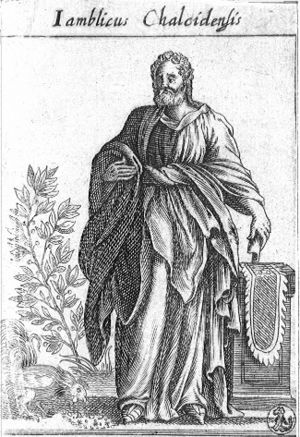Iamblichus facts for kids
Quick facts for kids
Iamblichus
|
|
|---|---|
 |
|
| Born | c. 245 AD Chalcis ad Belum
|
| Died | c. 325 AD (aged around 80) |
| Other names | "Iamblichus Chalcidensis", "Iamblichus of Chalcis", "Iamblichus of Apamea" |
|
Notable work
|
List
On the Pythagorean Way of Life (Περὶ τοῦ πυθαγορικοῦ βίου; De vita pythagorica), Protrepticus (Προτρεπτικὸς ἐπὶ φιλοσοφίαν), On the Egyptian Mysteries (Περὶ τῶν αἰγυπτίων μυστηρίων; De Mysteriis Aegyptiorum)
|
| Era | Ancient philosophy |
| Region | Western philosophy |
| School | Neoplatonism |
|
Main interests
|
Metaphysics, philosophical cosmology |
|
Influences
|
|
|
Influenced
|
|
Iamblichus (Greek: Ἰάμβλιχος Iámblichos; c. 245 AD – c. 325 AD) was an important Syrian Neoplatonist philosopher. He was of Arab origin. His ideas greatly influenced the future of Neoplatonic philosophy. He also wrote a biography of the famous Greek thinker Pythagoras.
Iamblichus's book Protrepticus is very important. It includes parts of a text by a writer known as the Anonymus Iamblichi. This text helps us learn about ancient Sophists.
Life of Iamblichus
Iamblichus was born in Chalcis, Syria. He came from a rich and well-known family. His ancestors were said to be priest-kings from an Arab royal family.
He first studied with a teacher named Anatolius of Laodicea. Later, he became a student of Porphyry. Porphyry was a student of Plotinus, who founded Neoplatonism.
Iamblichus and Porphyry had different ideas about a practice called theurgy. Theurgy involved rituals to connect with divine beings. Iamblichus wrote a book, De Mysteriis Aegyptiorum (On the Egyptian Mysteries), to explain his views.
Around 304 AD, Iamblichus went back to Syria. He started his own school in Apamea. This city was known for its Neoplatonic philosophers. At his school, he taught about the works of Plato and Aristotle. He also wrote many commentaries on their ideas.
For Iamblichus, Pythagoras was the most important teacher. He wrote a large work called Collection of Pythagorean Doctrines. This work had ten books, but only the first four and parts of the fifth still exist.
Iamblichus was known for his great knowledge and kindness. Many students came to learn from him. He lived with them in a friendly way. He passed away around 325 AD, during the time of Emperor Constantine.
Iamblichus's Ideas on the Universe
Plotinus had already developed Neoplatonism into a deep philosophical system. Iamblichus added his own changes to it. He made the system more detailed and used Pythagorean number symbolism more often. He also brought in ideas from Eastern cultures.
Iamblichus believed that the universe started with a single, perfect "One." This "One" was beyond everything we can understand. After this "One," he introduced a second "One." This second "One" helped create the world of intellect, or nous.
He also talked about the psyche, which is like the soul. He divided the nous into two parts: the "intelligible" (what we can think about) and the "intellective" (the act of thinking). These three parts – the psyche, and the two parts of nous – formed a group of three.
Iamblichus believed in a special creator-god called the Demiurge. He connected the Demiurge with the perfected nous. This idea was important for later Christian thinkers like St. Augustine.
Iamblichus greatly increased the number of divine beings in the universe. He spoke of gods, angels, demons, and heroes. He mentioned twelve heavenly gods, and many more gods that came from them. He also talked about guardian spirits for people and nations. He believed that the divine world stretched all the way down to physical nature. He thought that the soul could descend into matter and become a human being.
He used mathematics to explain his system. He believed that mathematical rules applied to everything, from divine beings to matter. He thought numbers were independent beings themselves.
Iamblichus also discussed nature. He said nature was bound by fate but could still be influenced by higher divine powers. These powers could turn bad things into good.
Iamblichus's Writings
Only a small part of Iamblichus's many books have survived. We learn about his ideas from fragments of his writings found in other books. His followers, especially Proclus, also wrote about his system. We also have five of his own books and parts of his big work on Pythagorean philosophy.
Some scholars believe Iamblichus wrote a famous book called Theurgia, or On the Egyptian Mysteries. However, its style and some ideas are different from his other works. So, some people wonder if he was the real author. But the book definitely came from his school. It tried to explain why people practiced polytheistic (many gods) rituals. This book was a key moment in the history of thought.
See also
 In Spanish: Jámblico para niños
In Spanish: Jámblico para niños

